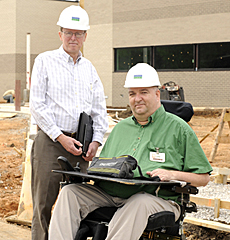UAB Alumnus Helps Break Down Barriers
By Jo Lynn Orr
 Phil Klebine (right), a UAB alumnus who works in the university's Department of Physical Medicine and Rehabilitation, is passionate about promoting equal access for individuals with disabilities. He is pictured above with Dan Kessler, executive director of
Phil Klebine (right), a UAB alumnus who works in the university's Department of Physical Medicine and Rehabilitation, is passionate about promoting equal access for individuals with disabilities. He is pictured above with Dan Kessler, executive director of
Disability Rights and Resources.Imagine going to a restaurant. When you get to the entrance, you look through the glass door and see others enjoying their dining experience. You reach for the door to enter, but there’s no handle. This is the emotional reality for many people with disabilities, says Phil Klebine, assistant director of research services in the UAB Department of Physical Medicine and Rehabilitation. For thousands of Americans, it’s impossible to enter buildings without curb cuts and ramps or read a restaurant menu unless it’s printed in Braille.
For decades, people with and without disabilities have worked to promote equal access and advocated for disability rights through public awareness activities, says Klebine, who earned his bachelor’s degree in communications in 1992 and his master’s degree in counseling in 2000, both from UAB.
Klebine, who lives with a spinal cord injury, has spent decades advocating for disability rights. He currently serves on the Governor’s Office on Disability State Advisory Council and is a board member for Disability Rights and Resources (formerly Independent Living Resources of Greater Birmingham).
"Disability Rights and Resources is a nonprofit organization that provides people with disabilities with services such as advocacy, peer support, independent living skills training, home modifications, nursing home transition, computer training, work incentives, and referrals to community resources,” Klebine says. The organization also helps with employment by assisting people with job searches and teaching resume-writing skills, he explains.
 The new home of Disability Rights and Resources, set to open this spring opposite the Birmingham Civil Rights Museum, will include educational displays about the history of disability rights in the United States. Click on the image above to view a larger version.In 2008, Klebine was president of the Disability Rights and Resources board when the organization made a commitment to build a new facility. “In searching for a location,” Klebine says, “we noticed a great area of land in the downtown area, which happened to be on the newly designated Civil Rights Trail and a block from the Birmingham Civil Rights Institute.” Disability Rights and Resources executive director Dan Kessler mentioned “that it would be nice if we could build space into our new facility for educational exhibitions that document the progression of disability rights,” Klebine recalls. “I thought this idea was fabulous because that progression has in many ways followed the advancement of rights for African-Americans.”
The new home of Disability Rights and Resources, set to open this spring opposite the Birmingham Civil Rights Museum, will include educational displays about the history of disability rights in the United States. Click on the image above to view a larger version.In 2008, Klebine was president of the Disability Rights and Resources board when the organization made a commitment to build a new facility. “In searching for a location,” Klebine says, “we noticed a great area of land in the downtown area, which happened to be on the newly designated Civil Rights Trail and a block from the Birmingham Civil Rights Institute.” Disability Rights and Resources executive director Dan Kessler mentioned “that it would be nice if we could build space into our new facility for educational exhibitions that document the progression of disability rights,” Klebine recalls. “I thought this idea was fabulous because that progression has in many ways followed the advancement of rights for African-Americans.”
In 2011, the organization broke ground for the new facility. It is expected to open this spring.
The facility’s spacious lobby will house exhibits and videos with educational information on the passage of major legislation such as the American Disabilities Act as well as other information that chronicles the advancement of rights for people with disabilities from a historical standpoint. “Once we get the facility up and running,” Klebine says, “we plan to be open during business hours for anyone who wants to come in and simply explore the facility’s exhibits, and we plan to offer scheduled tours for large groups.”
Long-range plans for the new facility include multiple programs targeting populations in rural communities, minorities, seniors, and youth groups. “One plan is to invite children with disabilities for summer programs,” Klebine says. “Kids may be using ramps and automatic doors when they enter public buildings, but they don’t know the history of how that access came about. We want kids to learn the framework of advocacy, help them learn the skills to become their own advocate, and show them how advocacy can make a difference.”
Another plan is to add a memorial garden named in honor of Miriam Witherspoon, the Birmingham City Council president pro tempore who died in 2009. Councilwoman Witherspoon, who also lived with spinal cord injury, was instrumental in advancing the rights of people with disabilities at City Hall and throughout the Birmingham area, Klebine says. “This garden area will feature a circular path with information kiosks that will provide biographical information on individuals who are pioneers in the advancement of disabilities rights. Helen Keller is one famous example,” he explains. But other lesser-known champions of disabilities rights also will be recognized along with more well-known names.
The organization is currently seeking funding for all of the planned projects. “I feel like this project is part of my legacy, and I’m extremely proud to be a small part of the team bringing this history to Birmingham” Klebine says. “I hope that once everything is in place, people, especially schoolchildren, who visit the Civil Rights District will visit our facility’s exhibits and garden. And I hope they leave with a new understanding of the history of disability rights.”